Numeracy and Data Analysis: Descriptive Statistics and Linear Forecasting Model
VerifiedAdded on 2023/06/08
|11
|1445
|373
AI Summary
This report analyses the temperature dataset collected for 10 consecutive days of London city. The report computes and discusses the mean, mode, median, range and standard deviation. Lastly, the report will forecast the 11th and 14th day temperature using linear forecasting model.
Contribute Materials
Your contribution can guide someone’s learning journey. Share your
documents today.
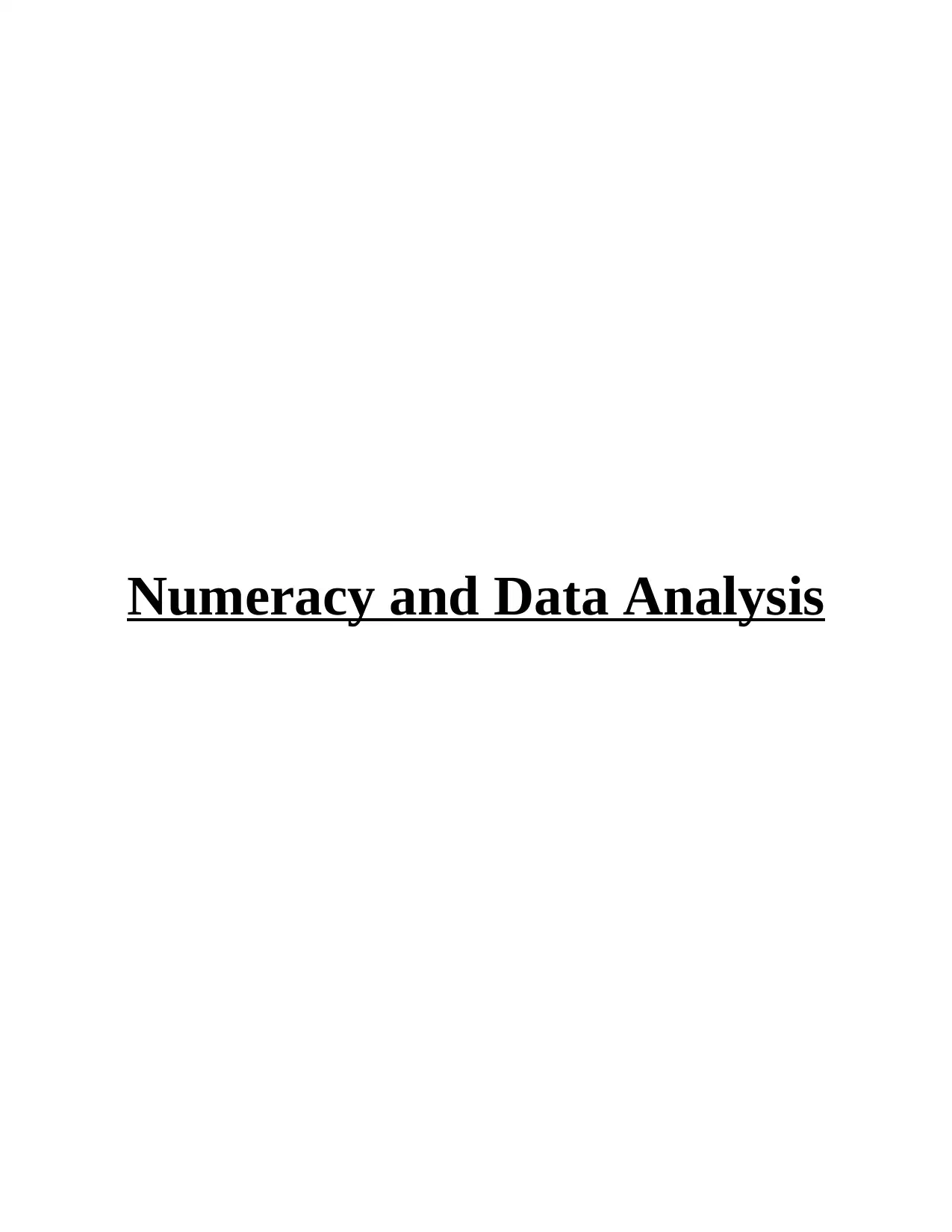
Numeracy and Data Analysis
Secure Best Marks with AI Grader
Need help grading? Try our AI Grader for instant feedback on your assignments.
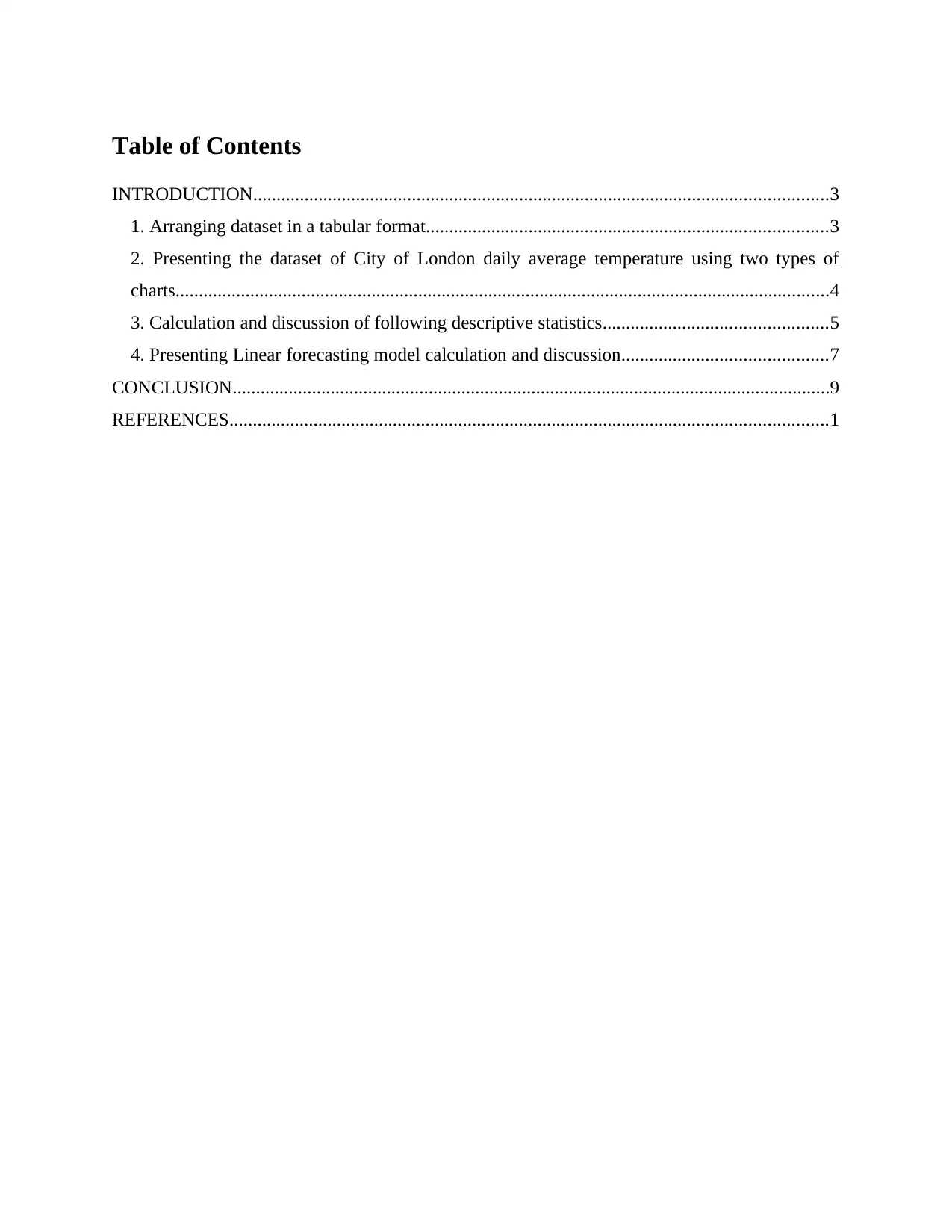
Table of Contents
INTRODUCTION...........................................................................................................................3
1. Arranging dataset in a tabular format......................................................................................3
2. Presenting the dataset of City of London daily average temperature using two types of
charts............................................................................................................................................4
3. Calculation and discussion of following descriptive statistics................................................5
4. Presenting Linear forecasting model calculation and discussion............................................7
CONCLUSION................................................................................................................................9
REFERENCES................................................................................................................................1
INTRODUCTION...........................................................................................................................3
1. Arranging dataset in a tabular format......................................................................................3
2. Presenting the dataset of City of London daily average temperature using two types of
charts............................................................................................................................................4
3. Calculation and discussion of following descriptive statistics................................................5
4. Presenting Linear forecasting model calculation and discussion............................................7
CONCLUSION................................................................................................................................9
REFERENCES................................................................................................................................1
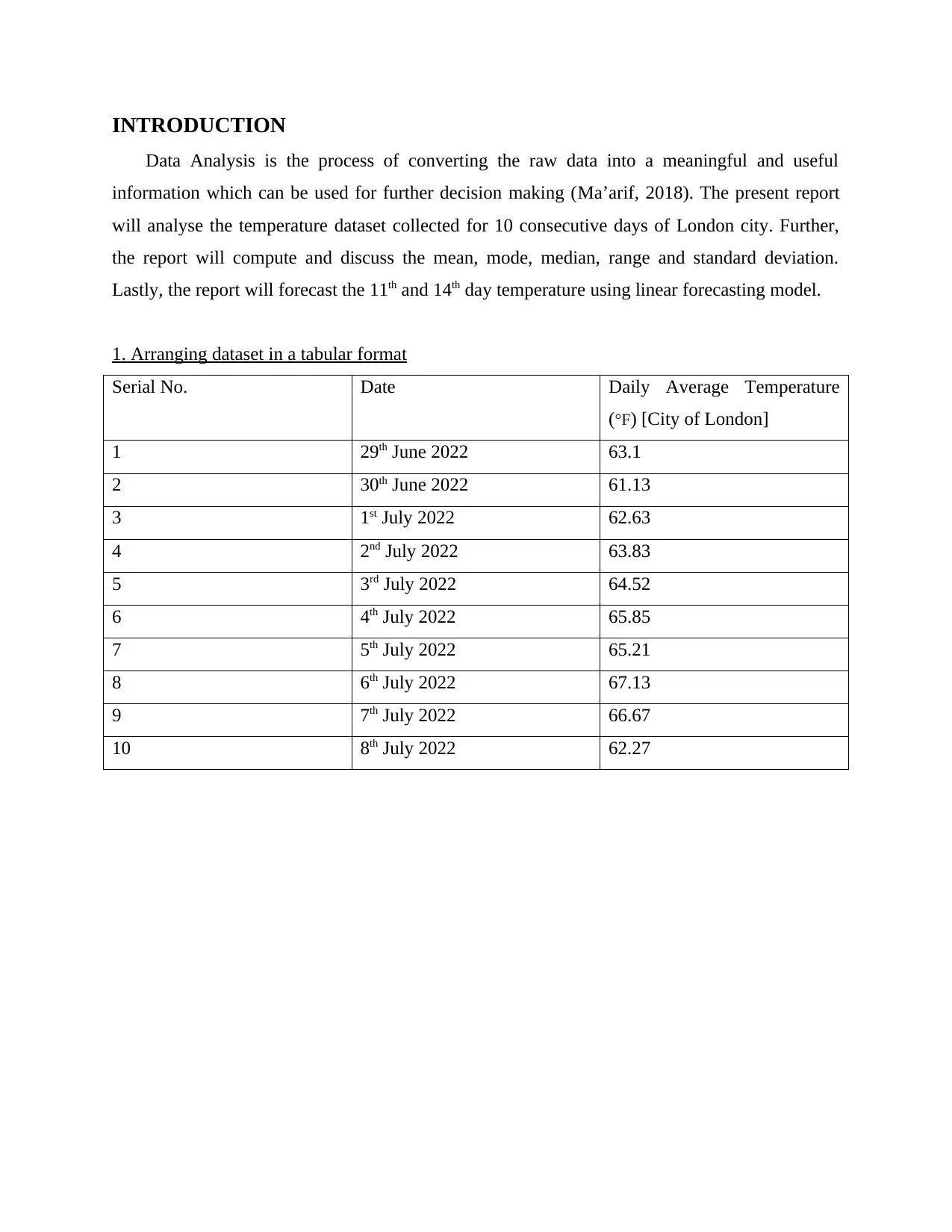
INTRODUCTION
Data Analysis is the process of converting the raw data into a meaningful and useful
information which can be used for further decision making (Ma’arif, 2018). The present report
will analyse the temperature dataset collected for 10 consecutive days of London city. Further,
the report will compute and discuss the mean, mode, median, range and standard deviation.
Lastly, the report will forecast the 11th and 14th day temperature using linear forecasting model.
1. Arranging dataset in a tabular format
Serial No. Date Daily Average Temperature
(°F) [City of London]
1 29th June 2022 63.1
2 30th June 2022 61.13
3 1st July 2022 62.63
4 2nd July 2022 63.83
5 3rd July 2022 64.52
6 4th July 2022 65.85
7 5th July 2022 65.21
8 6th July 2022 67.13
9 7th July 2022 66.67
10 8th July 2022 62.27
Data Analysis is the process of converting the raw data into a meaningful and useful
information which can be used for further decision making (Ma’arif, 2018). The present report
will analyse the temperature dataset collected for 10 consecutive days of London city. Further,
the report will compute and discuss the mean, mode, median, range and standard deviation.
Lastly, the report will forecast the 11th and 14th day temperature using linear forecasting model.
1. Arranging dataset in a tabular format
Serial No. Date Daily Average Temperature
(°F) [City of London]
1 29th June 2022 63.1
2 30th June 2022 61.13
3 1st July 2022 62.63
4 2nd July 2022 63.83
5 3rd July 2022 64.52
6 4th July 2022 65.85
7 5th July 2022 65.21
8 6th July 2022 67.13
9 7th July 2022 66.67
10 8th July 2022 62.27
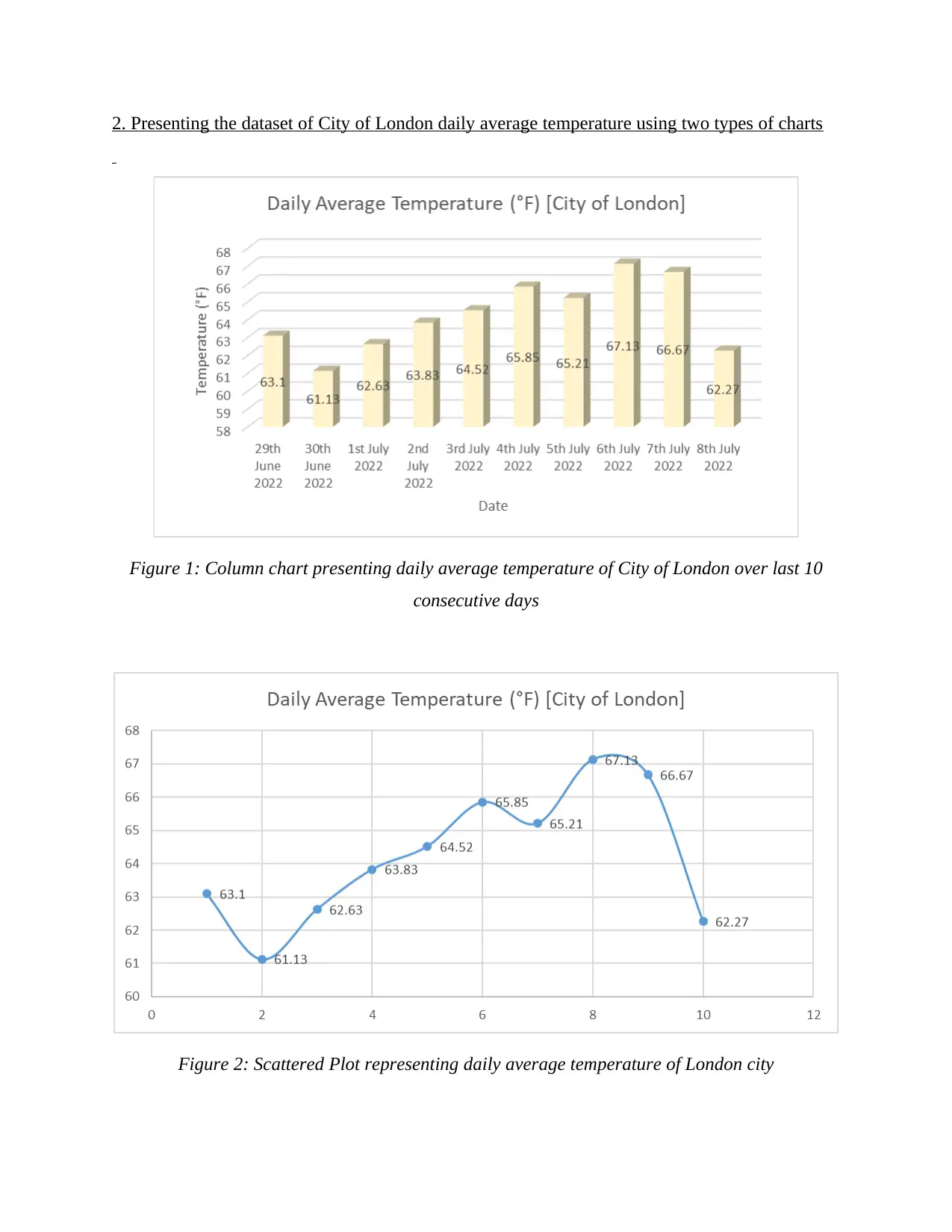
2. Presenting the dataset of City of London daily average temperature using two types of charts
Figure 1: Column chart presenting daily average temperature of City of London over last 10
consecutive days
Figure 2: Scattered Plot representing daily average temperature of London city
Figure 1: Column chart presenting daily average temperature of City of London over last 10
consecutive days
Figure 2: Scattered Plot representing daily average temperature of London city
Paraphrase This Document
Need a fresh take? Get an instant paraphrase of this document with our AI Paraphraser
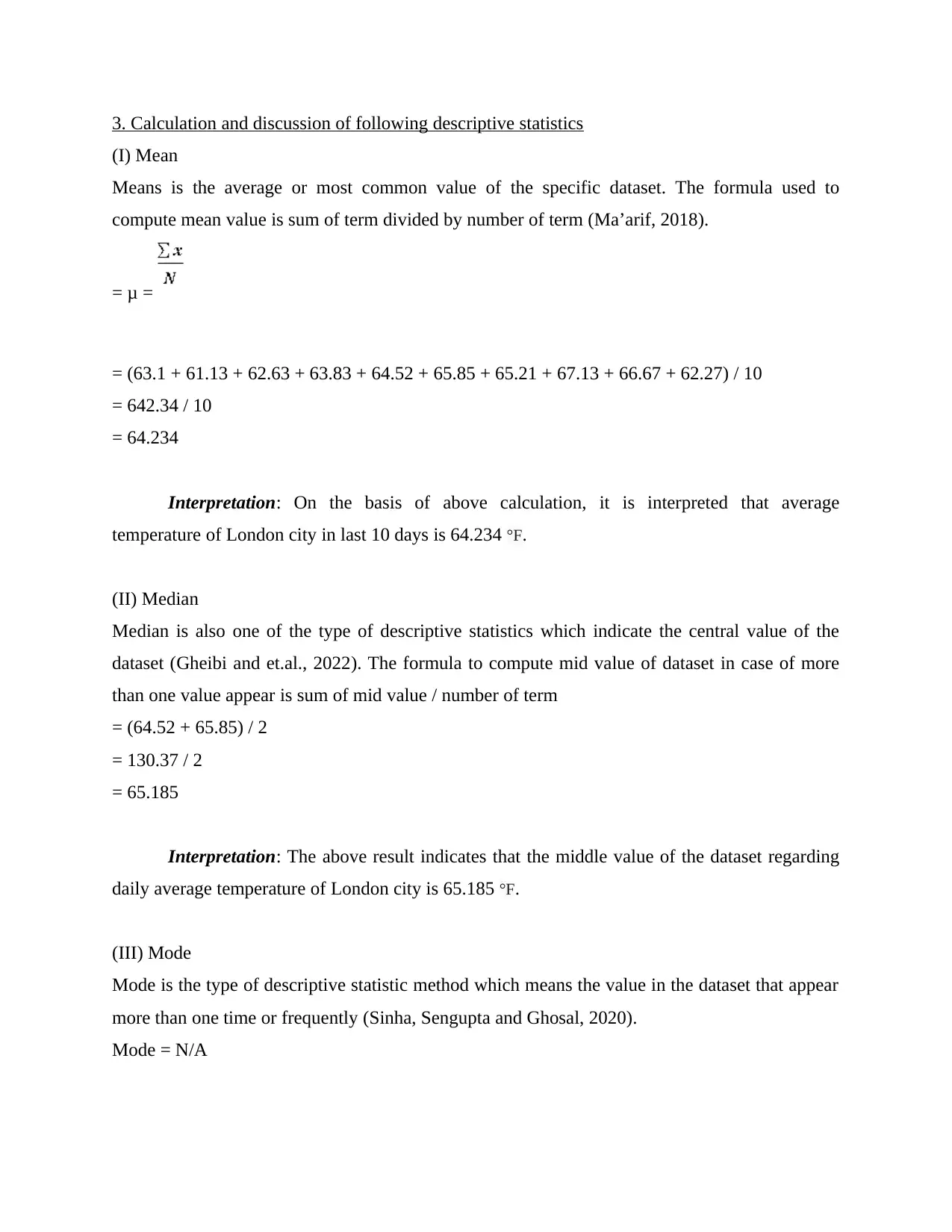
3. Calculation and discussion of following descriptive statistics
(I) Mean
Means is the average or most common value of the specific dataset. The formula used to
compute mean value is sum of term divided by number of term (Ma’arif, 2018).
= μ =
= (63.1 + 61.13 + 62.63 + 63.83 + 64.52 + 65.85 + 65.21 + 67.13 + 66.67 + 62.27) / 10
= 642.34 / 10
= 64.234
Interpretation: On the basis of above calculation, it is interpreted that average
temperature of London city in last 10 days is 64.234 °F.
(II) Median
Median is also one of the type of descriptive statistics which indicate the central value of the
dataset (Gheibi and et.al., 2022). The formula to compute mid value of dataset in case of more
than one value appear is sum of mid value / number of term
= (64.52 + 65.85) / 2
= 130.37 / 2
= 65.185
Interpretation: The above result indicates that the middle value of the dataset regarding
daily average temperature of London city is 65.185 °F.
(III) Mode
Mode is the type of descriptive statistic method which means the value in the dataset that appear
more than one time or frequently (Sinha, Sengupta and Ghosal, 2020).
Mode = N/A
(I) Mean
Means is the average or most common value of the specific dataset. The formula used to
compute mean value is sum of term divided by number of term (Ma’arif, 2018).
= μ =
= (63.1 + 61.13 + 62.63 + 63.83 + 64.52 + 65.85 + 65.21 + 67.13 + 66.67 + 62.27) / 10
= 642.34 / 10
= 64.234
Interpretation: On the basis of above calculation, it is interpreted that average
temperature of London city in last 10 days is 64.234 °F.
(II) Median
Median is also one of the type of descriptive statistics which indicate the central value of the
dataset (Gheibi and et.al., 2022). The formula to compute mid value of dataset in case of more
than one value appear is sum of mid value / number of term
= (64.52 + 65.85) / 2
= 130.37 / 2
= 65.185
Interpretation: The above result indicates that the middle value of the dataset regarding
daily average temperature of London city is 65.185 °F.
(III) Mode
Mode is the type of descriptive statistic method which means the value in the dataset that appear
more than one time or frequently (Sinha, Sengupta and Ghosal, 2020).
Mode = N/A
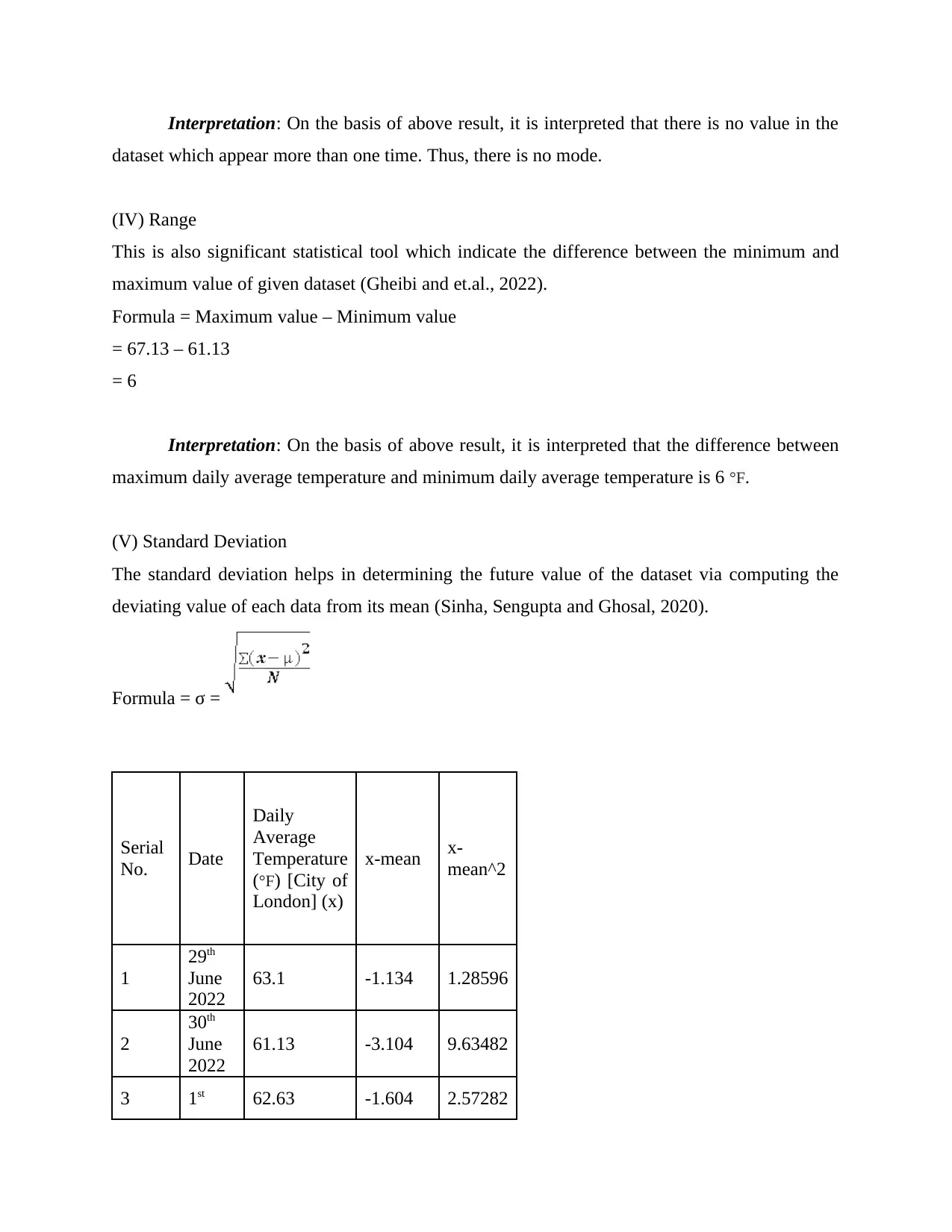
Interpretation: On the basis of above result, it is interpreted that there is no value in the
dataset which appear more than one time. Thus, there is no mode.
(IV) Range
This is also significant statistical tool which indicate the difference between the minimum and
maximum value of given dataset (Gheibi and et.al., 2022).
Formula = Maximum value – Minimum value
= 67.13 – 61.13
= 6
Interpretation: On the basis of above result, it is interpreted that the difference between
maximum daily average temperature and minimum daily average temperature is 6 °F.
(V) Standard Deviation
The standard deviation helps in determining the future value of the dataset via computing the
deviating value of each data from its mean (Sinha, Sengupta and Ghosal, 2020).
Formula = σ =
Serial
No. Date
Daily
Average
Temperature
(°F) [City of
London] (x)
x-mean x-
mean^2
1
29th
June
2022
63.1 -1.134 1.28596
2
30th
June
2022
61.13 -3.104 9.63482
3 1st 62.63 -1.604 2.57282
dataset which appear more than one time. Thus, there is no mode.
(IV) Range
This is also significant statistical tool which indicate the difference between the minimum and
maximum value of given dataset (Gheibi and et.al., 2022).
Formula = Maximum value – Minimum value
= 67.13 – 61.13
= 6
Interpretation: On the basis of above result, it is interpreted that the difference between
maximum daily average temperature and minimum daily average temperature is 6 °F.
(V) Standard Deviation
The standard deviation helps in determining the future value of the dataset via computing the
deviating value of each data from its mean (Sinha, Sengupta and Ghosal, 2020).
Formula = σ =
Serial
No. Date
Daily
Average
Temperature
(°F) [City of
London] (x)
x-mean x-
mean^2
1
29th
June
2022
63.1 -1.134 1.28596
2
30th
June
2022
61.13 -3.104 9.63482
3 1st 62.63 -1.604 2.57282
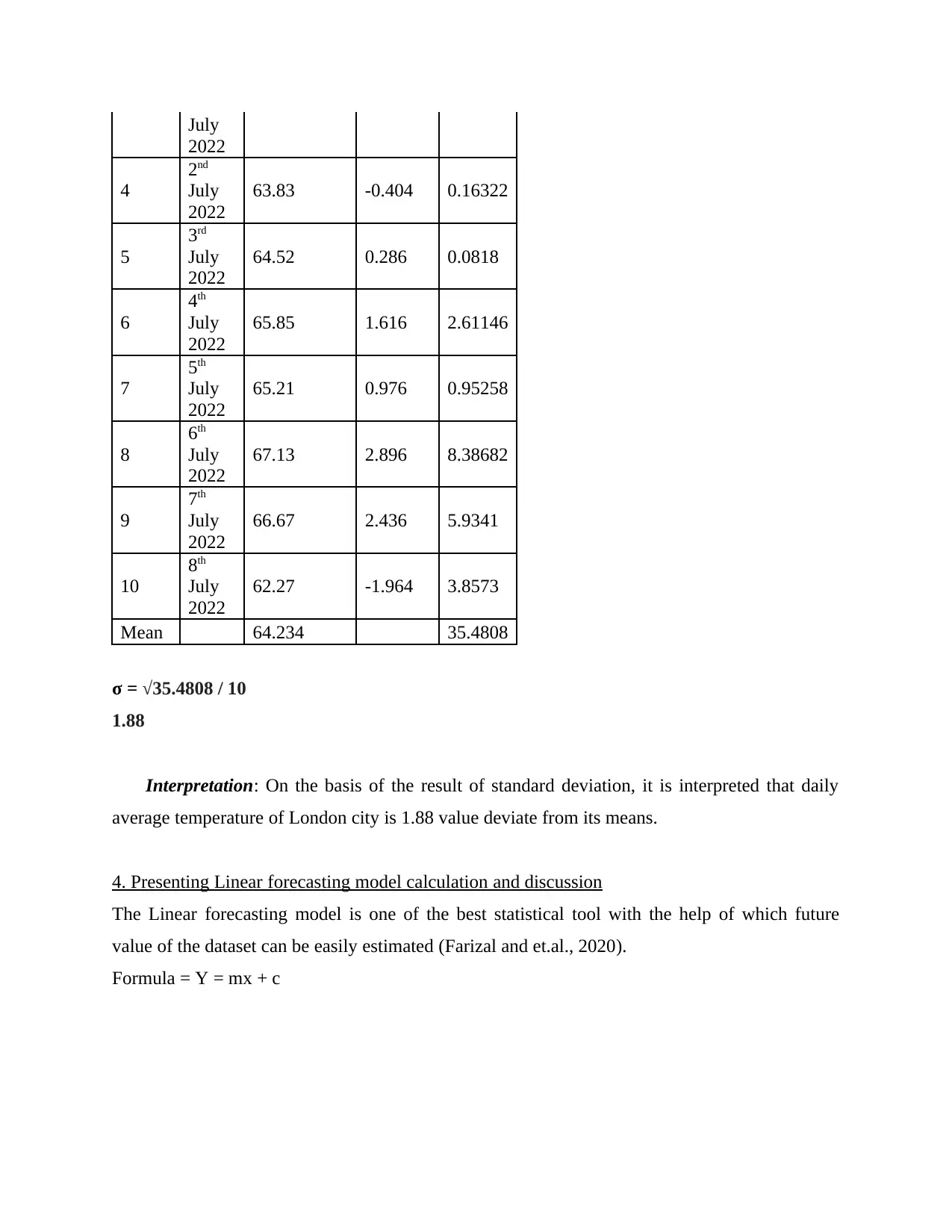
July
2022
4
2nd
July
2022
63.83 -0.404 0.16322
5
3rd
July
2022
64.52 0.286 0.0818
6
4th
July
2022
65.85 1.616 2.61146
7
5th
July
2022
65.21 0.976 0.95258
8
6th
July
2022
67.13 2.896 8.38682
9
7th
July
2022
66.67 2.436 5.9341
10
8th
July
2022
62.27 -1.964 3.8573
Mean 64.234 35.4808
σ = √35.4808 / 10
1.88
Interpretation: On the basis of the result of standard deviation, it is interpreted that daily
average temperature of London city is 1.88 value deviate from its means.
4. Presenting Linear forecasting model calculation and discussion
The Linear forecasting model is one of the best statistical tool with the help of which future
value of the dataset can be easily estimated (Farizal and et.al., 2020).
Formula = Y = mx + c
2022
4
2nd
July
2022
63.83 -0.404 0.16322
5
3rd
July
2022
64.52 0.286 0.0818
6
4th
July
2022
65.85 1.616 2.61146
7
5th
July
2022
65.21 0.976 0.95258
8
6th
July
2022
67.13 2.896 8.38682
9
7th
July
2022
66.67 2.436 5.9341
10
8th
July
2022
62.27 -1.964 3.8573
Mean 64.234 35.4808
σ = √35.4808 / 10
1.88
Interpretation: On the basis of the result of standard deviation, it is interpreted that daily
average temperature of London city is 1.88 value deviate from its means.
4. Presenting Linear forecasting model calculation and discussion
The Linear forecasting model is one of the best statistical tool with the help of which future
value of the dataset can be easily estimated (Farizal and et.al., 2020).
Formula = Y = mx + c
Secure Best Marks with AI Grader
Need help grading? Try our AI Grader for instant feedback on your assignments.
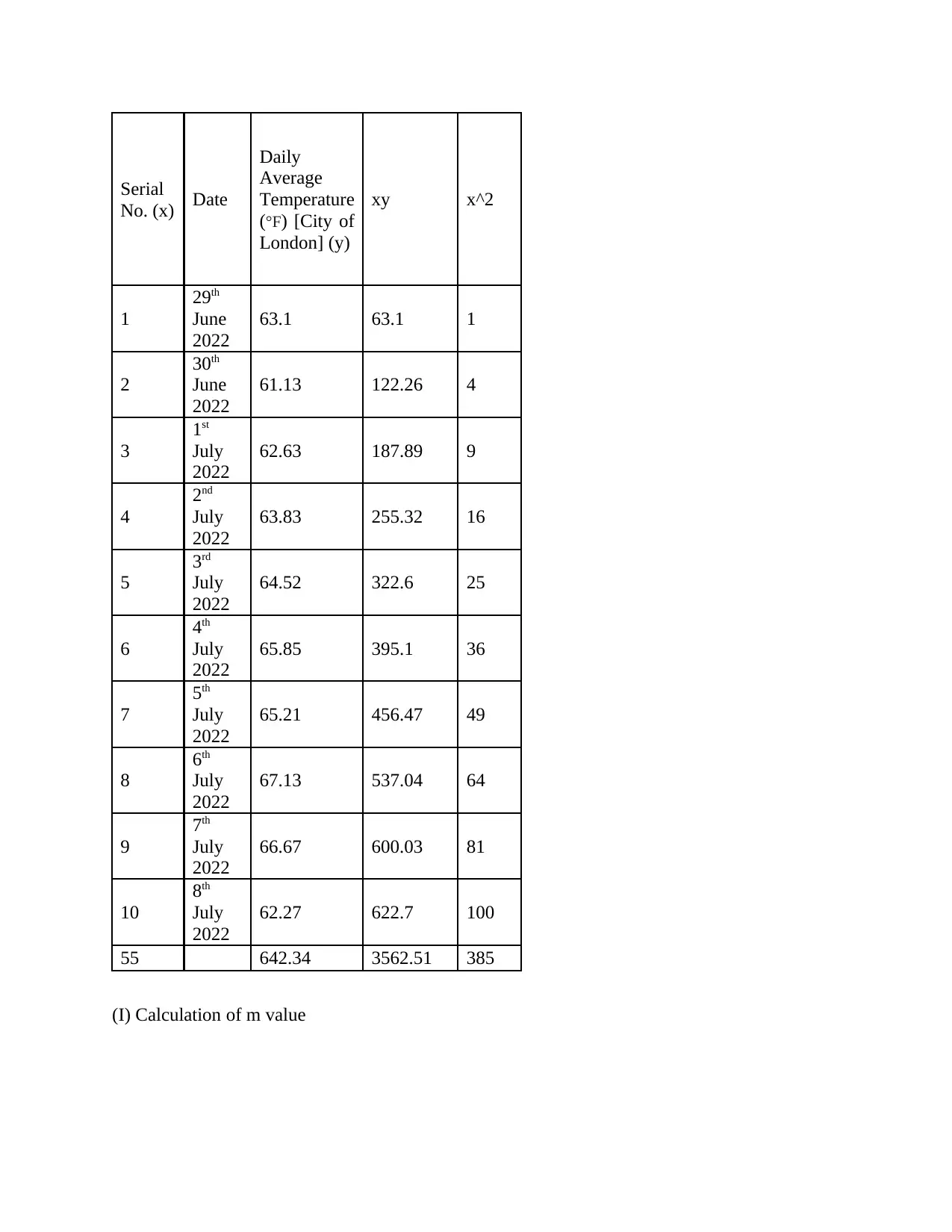
Serial
No. (x) Date
Daily
Average
Temperature
(°F) [City of
London] (y)
xy x^2
1
29th
June
2022
63.1 63.1 1
2
30th
June
2022
61.13 122.26 4
3
1st
July
2022
62.63 187.89 9
4
2nd
July
2022
63.83 255.32 16
5
3rd
July
2022
64.52 322.6 25
6
4th
July
2022
65.85 395.1 36
7
5th
July
2022
65.21 456.47 49
8
6th
July
2022
67.13 537.04 64
9
7th
July
2022
66.67 600.03 81
10
8th
July
2022
62.27 622.7 100
55 642.34 3562.51 385
(I) Calculation of m value
No. (x) Date
Daily
Average
Temperature
(°F) [City of
London] (y)
xy x^2
1
29th
June
2022
63.1 63.1 1
2
30th
June
2022
61.13 122.26 4
3
1st
July
2022
62.63 187.89 9
4
2nd
July
2022
63.83 255.32 16
5
3rd
July
2022
64.52 322.6 25
6
4th
July
2022
65.85 395.1 36
7
5th
July
2022
65.21 456.47 49
8
6th
July
2022
67.13 537.04 64
9
7th
July
2022
66.67 600.03 81
10
8th
July
2022
62.27 622.7 100
55 642.34 3562.51 385
(I) Calculation of m value
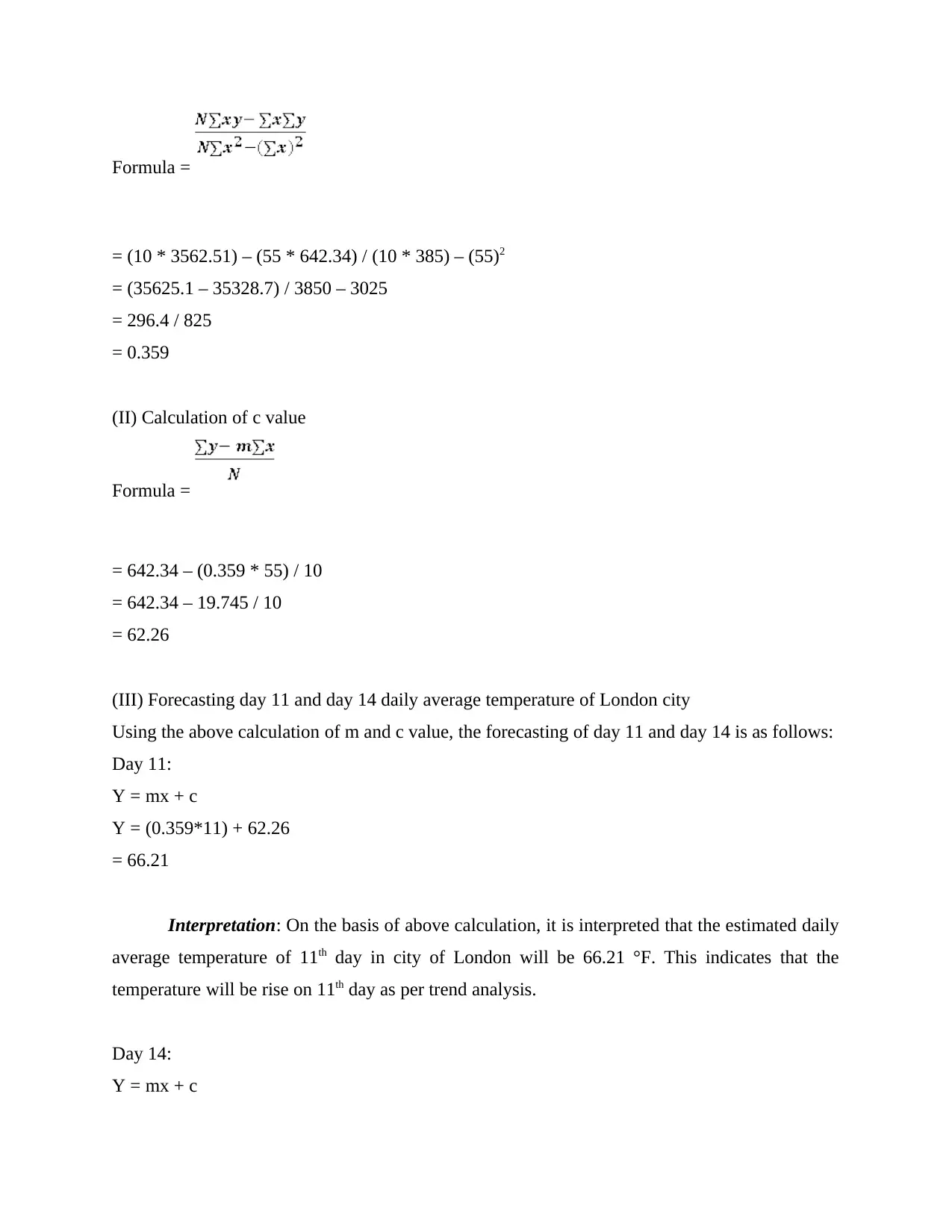
Formula =
= (10 * 3562.51) – (55 * 642.34) / (10 * 385) – (55)2
= (35625.1 – 35328.7) / 3850 – 3025
= 296.4 / 825
= 0.359
(II) Calculation of c value
Formula =
= 642.34 – (0.359 * 55) / 10
= 642.34 – 19.745 / 10
= 62.26
(III) Forecasting day 11 and day 14 daily average temperature of London city
Using the above calculation of m and c value, the forecasting of day 11 and day 14 is as follows:
Day 11:
Y = mx + c
Y = (0.359*11) + 62.26
= 66.21
Interpretation: On the basis of above calculation, it is interpreted that the estimated daily
average temperature of 11th day in city of London will be 66.21 °F. This indicates that the
temperature will be rise on 11th day as per trend analysis.
Day 14:
Y = mx + c
= (10 * 3562.51) – (55 * 642.34) / (10 * 385) – (55)2
= (35625.1 – 35328.7) / 3850 – 3025
= 296.4 / 825
= 0.359
(II) Calculation of c value
Formula =
= 642.34 – (0.359 * 55) / 10
= 642.34 – 19.745 / 10
= 62.26
(III) Forecasting day 11 and day 14 daily average temperature of London city
Using the above calculation of m and c value, the forecasting of day 11 and day 14 is as follows:
Day 11:
Y = mx + c
Y = (0.359*11) + 62.26
= 66.21
Interpretation: On the basis of above calculation, it is interpreted that the estimated daily
average temperature of 11th day in city of London will be 66.21 °F. This indicates that the
temperature will be rise on 11th day as per trend analysis.
Day 14:
Y = mx + c

Y = (0.359*14) + 62.26
= 67.29
Interpretation: On the basis of above calculation, it is interpreted that the daily average
temperature of London city will be 67.29 °F. It is estimated using the linear forecasting model.
The temperature will increase on the 14th day as per the trend analysis done using the past dataset
(Ratnam and et.al., 2019).
CONCLUSION
After summing up the above information, it has been concluded that the temperature of
London city on 11th day will be 66.21 °F and 14th day will be 67.29 °F. This is computed using
the linear forecasting model. Lastly, the report has also calculated the descriptive statistics tools
and comment on the results.
= 67.29
Interpretation: On the basis of above calculation, it is interpreted that the daily average
temperature of London city will be 67.29 °F. It is estimated using the linear forecasting model.
The temperature will increase on the 14th day as per the trend analysis done using the past dataset
(Ratnam and et.al., 2019).
CONCLUSION
After summing up the above information, it has been concluded that the temperature of
London city on 11th day will be 66.21 °F and 14th day will be 67.29 °F. This is computed using
the linear forecasting model. Lastly, the report has also calculated the descriptive statistics tools
and comment on the results.
Paraphrase This Document
Need a fresh take? Get an instant paraphrase of this document with our AI Paraphraser
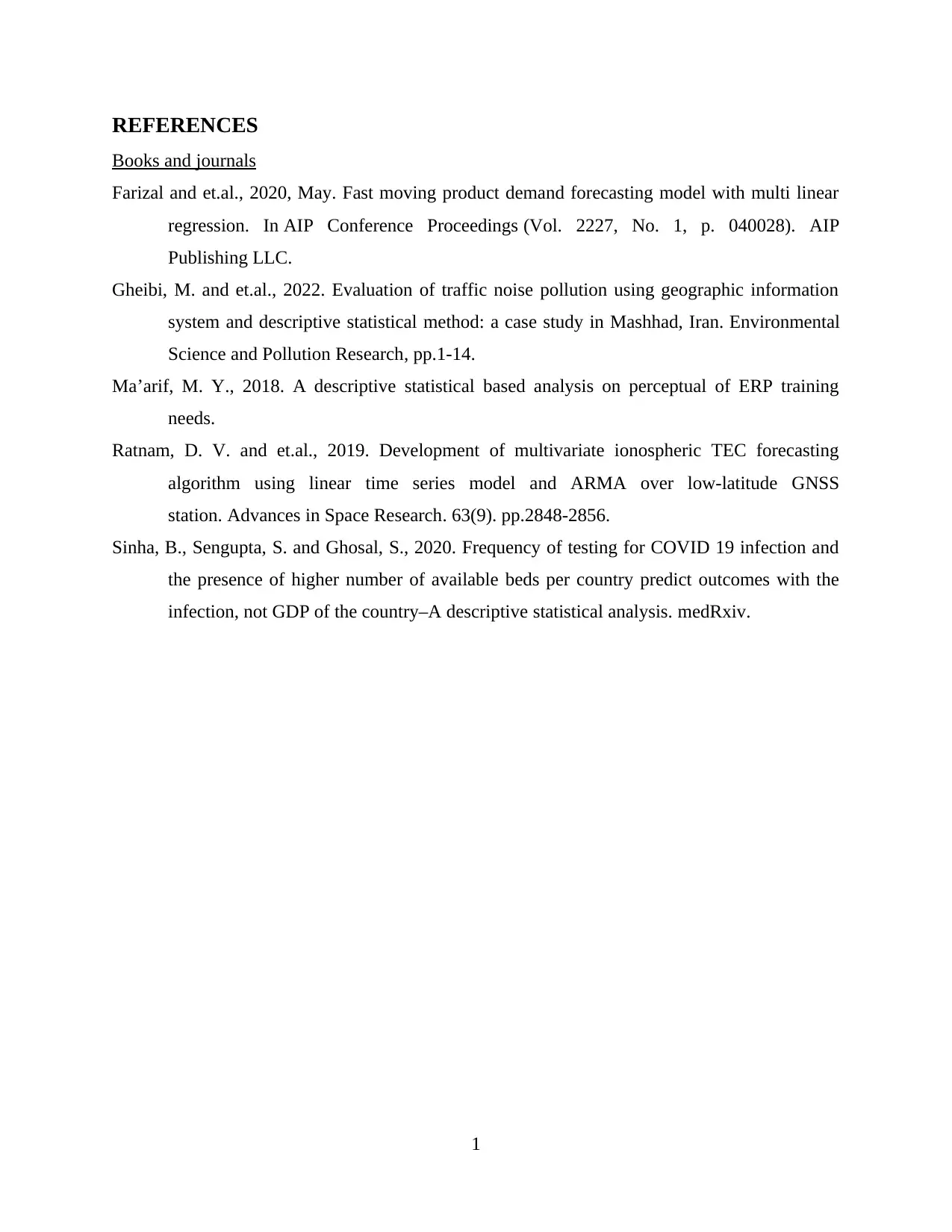
REFERENCES
Books and journals
Farizal and et.al., 2020, May. Fast moving product demand forecasting model with multi linear
regression. In AIP Conference Proceedings (Vol. 2227, No. 1, p. 040028). AIP
Publishing LLC.
Gheibi, M. and et.al., 2022. Evaluation of traffic noise pollution using geographic information
system and descriptive statistical method: a case study in Mashhad, Iran. Environmental
Science and Pollution Research, pp.1-14.
Ma’arif, M. Y., 2018. A descriptive statistical based analysis on perceptual of ERP training
needs.
Ratnam, D. V. and et.al., 2019. Development of multivariate ionospheric TEC forecasting
algorithm using linear time series model and ARMA over low-latitude GNSS
station. Advances in Space Research. 63(9). pp.2848-2856.
Sinha, B., Sengupta, S. and Ghosal, S., 2020. Frequency of testing for COVID 19 infection and
the presence of higher number of available beds per country predict outcomes with the
infection, not GDP of the country–A descriptive statistical analysis. medRxiv.
1
Books and journals
Farizal and et.al., 2020, May. Fast moving product demand forecasting model with multi linear
regression. In AIP Conference Proceedings (Vol. 2227, No. 1, p. 040028). AIP
Publishing LLC.
Gheibi, M. and et.al., 2022. Evaluation of traffic noise pollution using geographic information
system and descriptive statistical method: a case study in Mashhad, Iran. Environmental
Science and Pollution Research, pp.1-14.
Ma’arif, M. Y., 2018. A descriptive statistical based analysis on perceptual of ERP training
needs.
Ratnam, D. V. and et.al., 2019. Development of multivariate ionospheric TEC forecasting
algorithm using linear time series model and ARMA over low-latitude GNSS
station. Advances in Space Research. 63(9). pp.2848-2856.
Sinha, B., Sengupta, S. and Ghosal, S., 2020. Frequency of testing for COVID 19 infection and
the presence of higher number of available beds per country predict outcomes with the
infection, not GDP of the country–A descriptive statistical analysis. medRxiv.
1
1 out of 11
![[object Object]](/_next/static/media/star-bottom.7253800d.svg)



